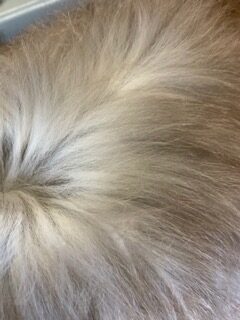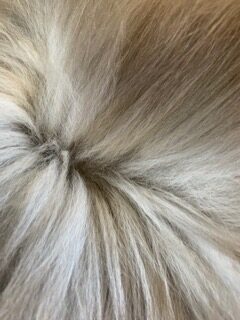
With such a large proportion of our members intending or already engaged in the making of angora knitwear, a little advice on the subject may prove useful. Some, indeed, are already well experienced hand spinners of sheeps wool and are exploring the possibilities of angora.
As with any handicraft, preparation is of premier importance. To make a first class garment it is essential to use raw angora matching in colour, texture and length (ideally 3” excluding tips], to produce a garment of even shade and fuss. Avoid using wool from the belly as this is much shorter and of a different texture and colour. The first coat that an angora produces is too soft to make a serviceable garment, in fact I prefer wool from a rabbit not less than eight months old. The outer growth of a show-coat has a limited use if plucked, the long wool being suitable only for such items as hats or head squares where there is very little friction, but it will have very little fluff. A clipped show coat is useless as will contain several growths of varying lengths. Do not attempt to spin anything less than two and half inches long, and all wool must be quite free from mats or the slightest webbing. Good yarn demands free flowing material.

We spin Angora as for worsted in wool, that is, keeping all fibres running in one direction, and controlling the spin at the first thumb and finger nearest the spinning wheel, not allowing the spin to run into the next section of unspun wool until a twist is felt at the point.
Angora felts easily under friction if it is not firmly spun, as you will soon find out if you knit it, let alone wear it, so the firm spin is essential. It is best to aim for a fine yarn, ensuring a lightweight garment of unmatched warmth that looks glamorous on even an XXOS! After all, we are dealing with a very expensive fibre that costs a minimum £1 an ounce to produce, based on feeding costs alone, without any allowance for labour and depreciation. Some of the coloured wool costs much more, so if the yarn was spun to the equivalent of a double knitting gauge in sheeps wool, not only would the garment be far too warm, but much too expensive.
The fluff on hand spun rises with the warmth of the hands and the friction of hand knitting. Any machine knitting produces a garment devoid of fluff. A garment of pure angora will give very little service, and cardigans and jumpers are best made with one ply angora knitting together with some other material, ideally sheeps wool of a very soft texture that blends in with our natural shades. The wool can be hand spun or mill spun, the latter in a very fine two-ply. I do not skein or wash my single ply angora, but use it straight from the bobbin, it being rather unmanageable and easily damaged. Neither do I ply it with other yarns, as a much smoother fabric results, the two yarns knitted together from separate bobbins.
Stocking stitch (one row knit, one row purl) cannot be used for hand spun yarn as the work will have a bias to one side with such a tight spin. Choose a ribbed pattern, cables or a lacy balance with sufficient wool forwards and purl stitches to balance the knit stitches. Since no two spinners spin alike, it is impossible to work to a “count system” as with ordinary knitting yarns on which published knitting patterns are based. Therefore, each spinner has to design garments around their own yarn, a matter of trial and error. Remember, the small the size of the needle used, the more likely the garment retains its shape in wear.
Once completed, sew up with very small stitches, using a backstitch or chain stitch. Safety pins placed at right angles to the edge at two inch intervals are a great help in matching patterns and keeping the seam level. Finally, wash the garment with all the buttons fastened, in a solution of warm water and mild detergent, rinsing well in water of the same temperature. Do not dry flat, but hang on a line without pegs, either in a breeze or above warm air. Above all, do not put it on a radiator: when dry, press. First pull the garment into shape and size, then spread a dripping wet cloth over it, then, using a very hot iron (not a steam iron), dab it all over, the resulting steam brining up the fluffy appearance.
Aim for perfection all the time, and soon you will be producing knitwear that will appeal to the most discriminating.
Article by Mrs B Pratley from the NAC Year Book